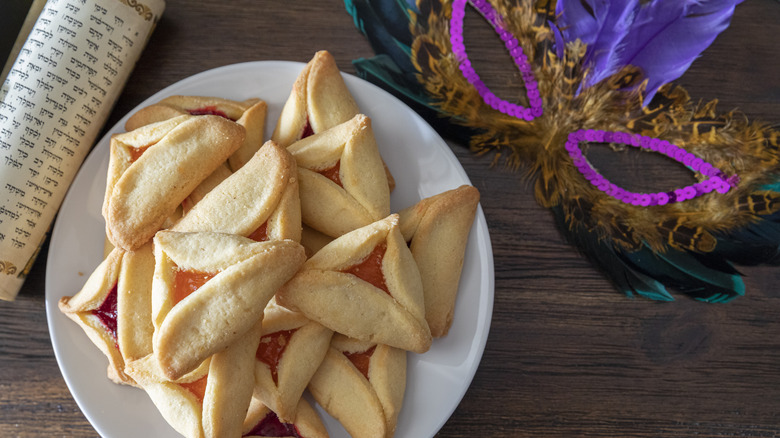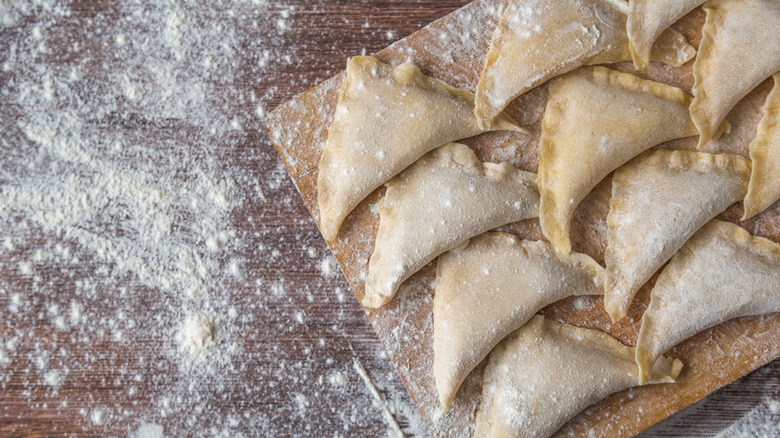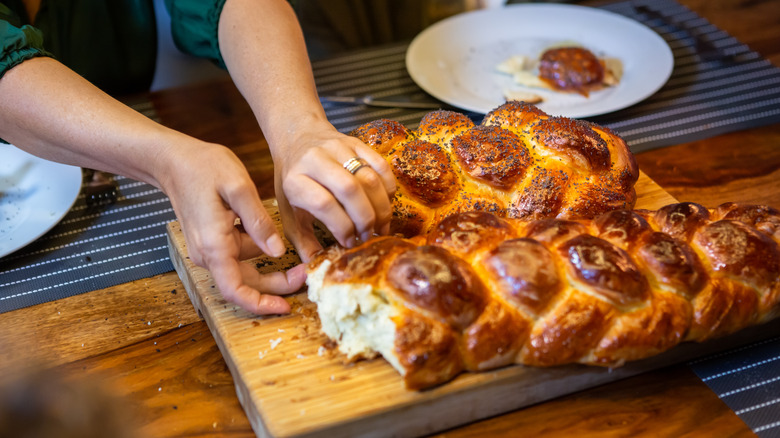Why Triangular Foods Are Eaten On Purim
Spring is a time of joy, hope, and celebration for many people, coinciding with several important religious and cultural holidays. This year, Purim, one such occasion, will be celebrated from sunset on March 23 to nightfall on March 24. The Jewish holiday commemorates the story of salvation and continued survival of the Jewish people in the face of plots against them during the Persian Empire's reign in the 5th century B.C. As told in the Hebrew Bible's Book of Esther, Haman, one of the king's advisors, was prevented from annihilating all Jews by the courageous appeals of young Queen Esther to the king. In honor of the story of her success in saving the Jewish people, partly through a banquet she hosted, the holiday is often celebrated with a range of customs which includes traditional feasting. Nowadays, dishes and delicacies served on Purim usually include an assortment of triangular foods.
From three-cornered hamantaschen to kreplach, these triangle-shaped pastries and dumplings are staple celebratory foods during Purim. Some Jews also enjoy preparing and indulging in other similarly shaped but not-so-traditional fares during the holiday, such as samosas and spanakopita. The reason behind celebrating with so many triangular foods connects back to the holiday's backstory. Why triangles, though? There are a few explanations for the special shape's popularity at Purim celebrations, most related to mocking the villainous Haman.
The symbolism behind the traditional triangle-shaped foods
When it comes to triangular foods prepared for Purim, the most popular is hamantaschen — also called "oznei Haman," or Haman's ears, based on a 16th century Purim comedy skit. Historically filled with poppy seeds, this stuffed cookie is made today with either savory or sweet fillings, including chocolate and fruit. The term "hamantaschen" is typically ascribed to Haman but can refer to mohn, the Yiddish word for poppy seeds; meanwhile, tasch is German for pockets. Based on etymology, hamantaschen is folded into triangles to represent Haman's three-pointed hat, his pockets, or his ears. Different Jewish communities may identify more with one explanation over another, supplicating it with other details from the Hebrew Bible. But no matter what exactly the pastry signifies, eating one is a symbolic act of dishonoring Haman and his memory — a steadfast signature of many of Purim's customs. For instance, when rabbis read from the Book of Esther on the holiday, it's typical for congregants to drown out Haman's name with noisemakers and shouting.
Kreplach, triangle-shaped dumplings filled with chicken or ground meat (but never pork, which isn't eaten for religious reasons), are also traditionally enjoyed on Purim, as well as on the eve of Yom Kippur and on Hoshana Rabbah. As each holiday is considered a day of judgment, the ingredients represent divine attributes of strength, kindness, and mercy. In this context, the food's shape has less to do with its consumption on Purim, but its contents serve as reminders of compassion in the face of cruelty.
Other foods served and shared on Purim
Triangular foods aren't the only ones traditionally enjoyed on Purim. In fact, many different dishes are prepared by Jews around the world, so when it comes to the best Purim recipes, you're sure to find a range of hearty entrees and sweet treats that appeal to all palates. At most Purim celebrations, you'll likely find dishes with poppy seeds, chickpeas, and various nuts. This is credited to the notion that Esther kept kosher while living in the palace so as not to break dietary laws.
However, many traditional foods are unique to specific regions. In particular, challah loaves are frequently enjoyed on Purim but aren't always prepared the same. Despite its many spellings such as koyletsh, koilitch, and kulich (not to be confused with Russian Easter bread), this long challah loaf made with raisins or candies often graces the holiday tables of Polish, Russian, and European Jews. Meanwhile, Moroccan Jews might celebrate with another type of challah called "Ojos de Haman" (or Haman's eyes), which includes almonds, poppy seeds, and hard-boiled eggs. Folares, similar challah-based pastries featuring eggs, are another Purim staple that originated among Sephardic Jews.
While triangular foods appear at many Purim celebrations, the wide variety of traditional delicacies and customs make the holiday a joyous one for Jewish people around the world. And since the Talmud directs Jews to spend the holiday drinking until they don't know the difference between "blessed is Mordechai" (Esther's first cousin) and "cursed is Haman," the food-filled celebrations are sure to be filled with just as much fun.


